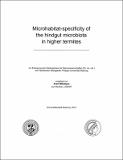| dc.contributor.author | Aram Mikaelyan, Katja Meuser, James Nonoh, Andreas Brune | |
| dc.date.accessioned | 2020-07-29T07:50:54Z | |
| dc.date.available | 2020-07-29T07:50:54Z | |
| dc.date.issued | 2013 | |
| dc.identifier.uri | https://repository.maseno.ac.ke/handle/123456789/1663 | |
| dc.description.abstract | The higher termite gut is a highly structured habitat and shows the presence of spatially separated compartments. The differences in physicochemical parameters between the compartments, most importantly pH, play an important role in shaping the local community structure. Most of the previous community studies on compartments have been limited to the study of very closely related termites. However, a deeper understanding of how these communities evolved could only be gained by the comparison of compartments from more distantly-related termites. Here, we apply 16S rRNA gene pyrosequencing to investigate the bacterial communities in the hindgut compartments of five different termite species, belonging to the subfamilies Termitinae and Nasutitermitinae. Our results show that despite the co-diversification of the gut community with the termite host, bacterial communities in homologous gut compartments are more phylogenetically related to each other than to consecutive gut compartments in the same termite. We hypothesize that similar ecological conditions such as increased alkalinity in the anterior gut have played a significant role in the structuring of communities in the gut compartments of higher termites. | en_US |
| dc.publisher | M icroha bitat-specificity of the hindgut microbiota in higher termites | en_US |
| dc.subject | Termites, physicochemical , | en_US |
| dc.title | Compartment-specific bacterial communities in higher termites | en_US |
| dc.type | Article | en_US |

